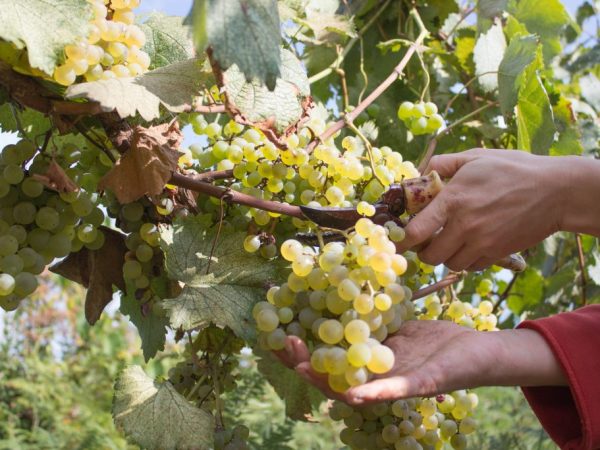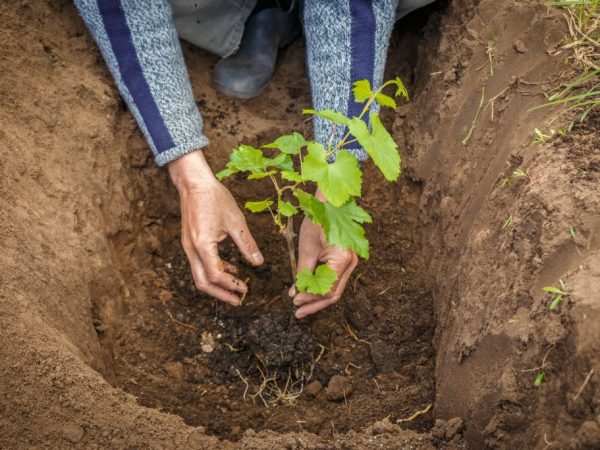Description of grapes Korinka Russian
Early maturing varieties are popular for producing a stable harvest. Grape Korinka Russian belongs to frost-resistant varieties. The variety is resistant to diseases that are transmitted between horticultural crops.

Description of grapes Korinka Russian
Characteristics of grapes
The crop has a high yield, which does not depend on weather conditions - even in a rainy summer, a good harvest can be harvested from the bush. For a year from 1 hectare. going up to 85 c. berries. The grape Korinka Russian bears fruit on days 110-115. The harvest is kept on the vine for a long period and does not deteriorate.
The variety is distinguished by good transportability: on long trips, the berries do not lose their presentation. According to its characteristics, the variety has no peas, and there are no seeds inside the berries. Even without shelter, the bush can withstand up to -20 ° C. The grapes are self-pollinated, therefore they do not depend on the activity of insects.
Description of the bush
Vigorous bushes grow rapidly. According to the description, the length of the shoots is up to 3 m. To form the shape of the bush, excess lashes are trimmed once a year. Grapes have bisexual flowers.
The grape leaves are large, they have a weak degree of dissection and minimal cobweb pubescence. The vine ripens fully, which allows you to get a stable harvest every year.
Description of fruits
Small berry. It has an oval shape and a dense light color (golden yellow) skin. The berry often forms a blush from sunlight. The pulp is juicy and fleshy. The aroma of the fruit is weak.
Description of bunches:
- the bunch is medium in size;
- the shape of the bunch is elongated and loose;
- only 1 bunch is formed on one shoot.
According to the characteristics, one berry contains up to 22% sugar. The acidity of the fruit is average. Berries are used for making juices, twists and eaten raw.
The good taste of the berries is used in cooking: a delicious juice with a delicate sweet aftertaste is obtained from the bunches.
Growing grapes
According to the description of the grape variety Korinka Russian, the culture is grown on the south side, because is photophilous. It is better to plant the seedling away from other crops: grapes do not like the neighborhood of fruit trees. You cannot plant a seedling in the shade or in a draft - in such conditions, the culture will not grow properly, and the harvest will be weak. The planting of grapes is planned at the beginning or end of the growing season.
Landing in the soil

Prepare the landing pit in advance
The planting pit is prepared a month before planting the seedling. The optimum depth for the hole is 90 cm (this depth is enough for a large root system of grapes to grow). As fertilizer for the planting pit, compost or ordinary manure diluted with water is used.
If several seedlings are planted at once, there should be a distance of at least 3-4 m between them. After immersion in the hole, the seedling is covered with soil, which is rammed. The young shoot is watered (at least 5-10 liters of water are used).The water is preheated in the sun. Additionally, a support is installed - it will allow the seedling to grow up correctly. The height of such a support is at least 1.5 m. After planting, for the first month, the bush is watered abundantly, and then the irrigation and fertilization regime is established.
Plant care
When growing Korinka Russian, watering, fertilization of the soil and pruning of excess vines are organized. Abundant watering is needed during the warm season. The warmer it is outside, the more moisture is introduced. The soil is fertilized no more than once a season. Do not apply too much organic or mineral fertilizers.
For the rapid growth of Korinka Russian, trimming of excess lashes is needed. Broken branches are pruned as needed: the main procedure is carried out in early spring before fruit formation. Diseased branches are cut, which can cause illness of the entire bush. The cut site is treated with a disinfectant solution.
Once a season, the soil is loosened: such measures can improve the throughput of the soil, and increase the efficiency of irrigation. Loosening helps to get rid of the spores of the fungus, which can be stored in the ground. For a frost-resistant crop, no shelter is made for the winter: as soon as the processes in the bush slow down, watering and fertilization of the soil stops.
Diseases and pests
Russian corinka is resistant to gray rot, but not protected from powdery mildew. Hornets and wasps threaten the culture. To protect the grapes from insects, special nets are used. It is useful to ventilate such a culture and rinse with water. For the bunches, bags are used, which also reduce the influence of insects on the harvest. Good trap efficiency.
Prophylaxis
Remove all damaged tree branches in the fall, then completely treat with copper sulfate. Spring prophylaxis consists in spraying the kidneys with copper sulfate (concentration 3%). Processing with Cumulus and Quadris will save the bush and neighboring crops from oidium.
Conclusion
The Korinka grape is a popular variety with increased winter hardiness. It is quickly accepted and started to grow. The bush gives a good harvest every year. The variety is unpretentious in care, rarely gets sick.


